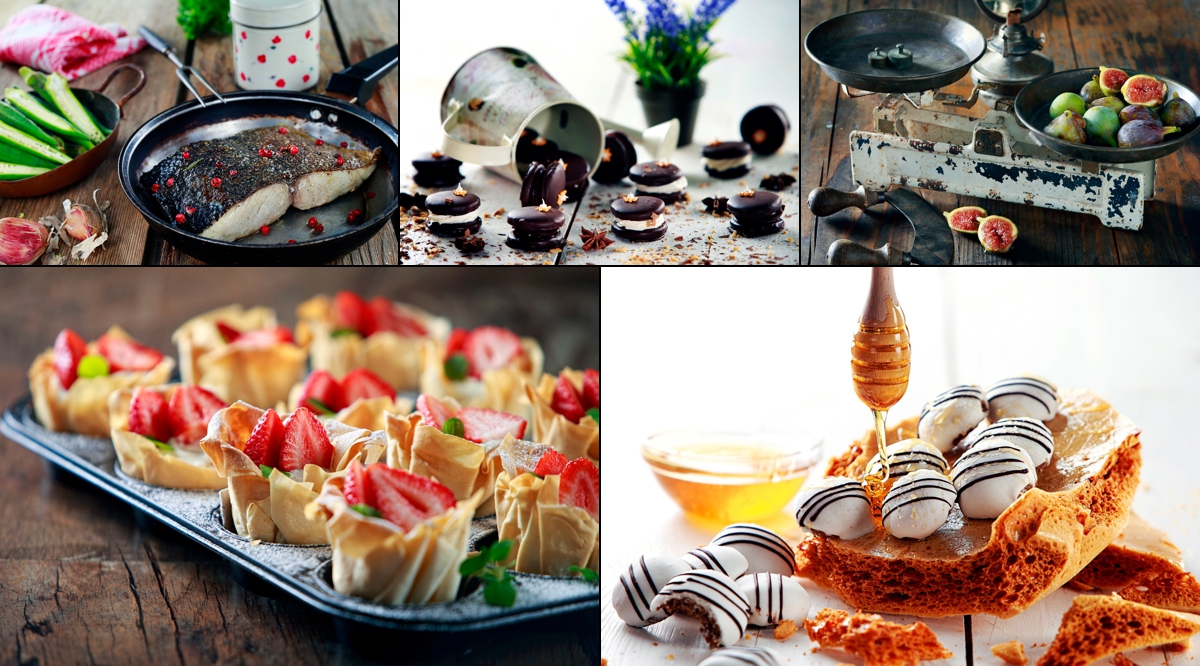Our friend Marko Dušak of SpinakerGraphics, is an award-winning wedding photographer in Croatia whose work we’ve long admired. Recently, he expanded his business to food photography by starting Hungry Foodography. We asked him to tell us more about this new venture, and his brand new “mother’s vintage kitchen” he built in his studio.
All images © Hungry Foodography
When did you start Hungry Foodography and why?
My wife Željka and I started Hungry Foodography four months ago. The reason is that I fell in love with taking photos of food. It didn’t started suddenly. In fact, I have been a wedding photographer for over ten years now. But, I enjoy food, know how to cook and how to recognize good food, so it started as a hobby alongside wedding photography. When my wife used to prepare and arrange food, I often took photos of it.
I received an inquiry in September from a large Croatian company Konzum. They asked me to do photography of Christmas desserts for a cookbook. I hesitated at first because I was a wedding photographer, not a food photographer, but because I have a large and equipped studio for product photography, and a lot of experience with it (working for Metro Cash & Carry for years, doing product and fashion photography for their catalogs), I decided to take the offer and start this adventure together with my wife. We had great luck working with top pastry chef Mirjana Špoljar who is a three-time pastry champion in Croatia, and from whom we’ve learned a lot about arranging food.
After we delivered photography to their creative agency, they were surprised by their quality and were very satisfied. Back then they announced some new projects, which we’ve already done by now. We’ve realized that people liked what we do and also our photography style. So then we decided to create a brand for food photography called Hungry Foodography. We’ve equipped our studio with all the necessary accessories for arranging food (vintage plates, wooden pads, vintage old forks, knives, spoons, shabby chic old tables, glasses, etc. ). Also, we’ve installed all the necessary equipment for making food (a microwave, a cooker, a fridge, etc.) so that chefs could have everything they need when they come to our place to make the food that we’ll use for photographing.
Besides that, when I was studying books and Internet sites for food photography, I realized that I would have to invest in the equipment. Although I only work with Canon prime L lenses, I’ve decided to go to Zeiss lenses (Macro planar T 2/100, Macro planar T 2/50 and Distagon T 2,8/21). Because there was no need to switch camera system I used my Canon Eos 1Dx and Canon EOS 5 D MKIII.
I also didn’t change the lighting. I use Bowens flash heads and light modifiers but I got a couple of different soft boxes and light modifiers specific for food photographing and of course numerous flexible arms, clamps, magic arms, super clamps, etc. SpinakerGraphics stays as a master brand and we still do wedding photography as well as the food photography.
How will this new kitchen help with the business?
When I photograph food I’m usually near plates in which we arrange food, so the background is not so important. But, there are situations in which I needed some more attractive background and I didn’t have it, so I came up with the idea to make a vintage grandma’s kitchen. Taking into consideration that we have a pretty large studio, building a kitchen didn’t present a problem because it still leaves enough space for product photography. We needed some time to gather everything – we bought a vintage fridge and a cooker and had them varnished. I found chairs, tables and kitchen cabinets at an old furniture store, which is owned by this man who had them redone to look vintage.
Little by little we gathered everything and called craftsmen who built wooden walls and floors according to our concept and project, and we varnished and furnished walls and floors.
Now when I want wider frame for photographing food, and want to present how the food looks in a vintage scene, I don’t have a problem because there is always some part of a vintage kitchen in frame. Also when I’m photographing a chef for an interview or something else, I have a beautiful background and everything is in my studio.
How did you learn about photographing food, rather than people?
First, I bought all kinds of books about food photography – light set up and books about arranging food. I’m a big Stephen Hamilton fan and read his Who’s Hungry Magazine, where I found a lot of inspiration. When I look at some attractive food photos, I always try to find out what the lighting set up was in the studio, and try to do the same in my work.
Through this business my wife Željka and I realized that half of work done is in the photographing food and the other half is arranging it. So, that is why we got so many cookbooks and books about different styles when it comes to arranging food from which we learn so much.
What has been the biggest challenge with photographing food? And what do you love most?
Biggest challenge for us is arranging food because a good photo of badly arranged food won’t look delicious. It is necessary to be patient, creative and to make prepare well to get a great and attractive photo which makes people hungry as soon as they see it. As a matter of fact, now I will reveal how the brand name came to life: we wanted to accomplish that viewers get hungry when looking at our photos so it is natural that our name is Hungry Foodography!
Food arranging is really complex work so my wife and I divide it – she gets to do the food arranging and I do the photographing, so we work as a team. We can’t pull it off alone and all photos are a result of two people working together.
I personally like exploring light settings the most while photographing food. I like playing with the light, masking it partly and bounce partly too so I get a beautiful game of lights and shadows on photos. I also like playing with small depths of field so I could get an accent on specific parts of photo.
Check out SpinakarGraphics or Hungry Foodography for more great work by Marko and Željka Dušak.








